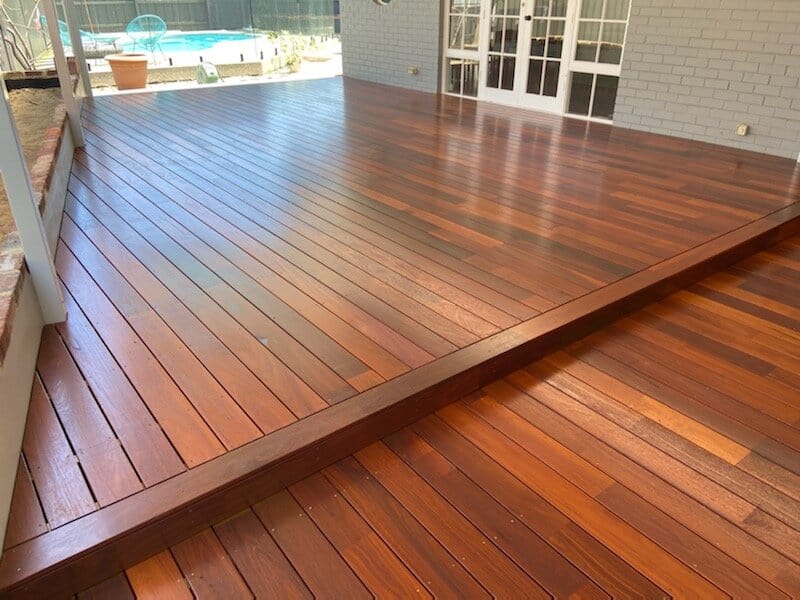A deck is a quintessential part of the Australian lifestyle. We love spending hours outdoors, whether it is taking a dip in the pool or having a BBQ with friends. This is especially true in Western Australia, where we experience more sunny days per year than any other capital city.
When many people are preparing their backyards for the warmer months, they tend to concentrate on the garden and lawn, neglecting the deck. If you want to keep your deck looking great, it is important to implement a maintenance schedule. In this article, we will outline composite decking and timber decking maintenance in an easy, step-by-step guide.
 Source: Trex
Source: Trex
Types of decking
Two types of commonly used decking materials are traditional timber and composite timber. The more widely used of the two is traditional timber. Timber appeals to many people because of its general aesthetic. Nothing looks quite the same as a wood deck.
Composite timber also has many beneficial qualities. It has increased in popularity since its emergence on the market in the early 90’s. Even though it is initially more expensive to install than timber, it may last longer and is much easier to maintain.
Why maintain?
It’s a common misconception that decks will last forever. Even if timber is pressure-treated to protect it against insects and decay, it will still deteriorate from the elements, dirt and general wear and tear. Regular maintenance is required to keep it looking like new for many years to come.
Decking is an investment that can be protected by extending the product’s life. As well as reducing the need to replace the decking altogether, deck maintenance has the added benefit of returning 80% of its original cost by adding value to your home. In order to get that level of return, it is crucial to look after your investment.
What do you need?
Manufacturers will recommend specific cleaning solution to use for their timber or composite decking products. It is important to follow this advice as other products may cause damage to the deck’s surface. If you are unsure which cleaning product to use, contact your timber merchant.
If you do not have any of the following items, head down to your nearest hardware store. The staff there will be able to recommend the best products for your needs.
- Hose
- Soft bristled brush
- Broom
- Decking oil (optional) and application tools
- Pressure washer (optional)
Maintenance Steps
- Clear the area
Clear the deck of all items, including furniture, cooking equipment, plants and any decorative pieces. It is important to remove all items from the deck, as this will allow you to access the deck in its entirety. Take care while movie heavier items and avoid dragging furniture to avoid scratching the deck. If you do not have space to temporarily store deck items, position them neatly in a corner. If any items are too heavy to move, cover them with plastic sheeting or a tarp to prevent any damage from cleaning products.
- Sweep
Before beginning the cleaning process, it is important to remove any dirt and debris like from the deck. Not only can the debris create problems if it decomposes and becomes acidic, it can also create small, unsightly scratches. Use a broom to sweep the deck, taking care not to scratch the deck surface.
- Scrub
Using a recommended cleaning product and a soft bristled brush, scrub the deck. It is a labour-intensive task, but doing it by hand will give you the best results.
The alternative to this is a pressure washer. Pressure washers are an extremely effective tool, but you need to be careful when using it as can be potentially ruin the wood. They are not recommended for some composite decking. When using a pressure washer, hold it at least 30 centimetres away from the wood and do not hover over the same spot for too long. Ensure that the pressure setting is not too high. The most efficient method of cleaning with a pressure washer is to do it row by row, as if mowing a lawn.
- Rinse
Even when using the correct cleaning solution on your deck, neglecting to wash away soap and suds can cause problems over time. Potential consequences include discolouration and surface damage, causing decking to look old and worn. Thoroughly rinse away any soapy residue with a garden hose.
- Dry
Placing objects back onto the deck before it is completely dry are likely to scratch the deck’s surface. Fortunately, in Western Australia, things tend to dry off quickly so you may not have to wait too long.
- Seal
After you have cleaned your deck and given it time to dry, you should apply an oil to help maintain your decks condition. Ask your local timber merchant which oil is most compatible for use with your decking. Keep in mind that composite timber does not usually require regular sealing, so skip this step if your deck is made of composite timber.
Other tips
Inspect the deck – While performing maintenance on your deck, it is a good time to inspect the deck. Pay close attention to any areas that are close to the ground or near sources of water, as they are going to be most likely spots for damage to occur. Look for signs of rot, loose nails or screws, as well as any cracks.
Maintain the deck’s perimeter– Prune trees and bushes near your deck. It will help maintain the condition of your deck and decrease the occurrence of mould, rot and mildew.
Move things around the deck –Leaving objects on wood for too long without moving them can cause wood discolouration. This can be avoided by moving objects around periodically.
How often?
As previously mentioned, timber requires more maintenance than composite. Consider completing the above steps every 6-12 months. With composite decking, a yearly cleaning session is adequate maintenance for most residential decks.
Decking is an Australian necessity. We spend a lot of time outdoors, so it is important to know how to properly maintain outdoor spaces. We hope this article has made you aware of the importance of decking maintenance and has given you the necessary information to keep your deck in top condition.



































